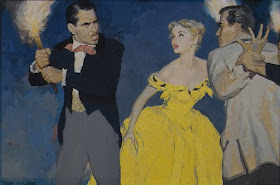I didn't notice any useful biography on a brief Google search, but I can report this: He was born in San Diego, trained in Los Angeles' Chouinard and then at the Brooklyn Museum. Worked in Hollywood, but his main career was with the famed Cooper Studio in New York. He retired to Hilton Head, South Carolina.
His style was similar to that of Coby Whitmore and several others active in the 1950s. Such illustrations typically offered only enough background and stage-setting details to provide context. Featured were the subject person or persons, often as only heads and shoulders. Media was usually gouache or casein, these allowing for rapid work and lack of the messiness that oil paints might cause when works are transported.
De Mers did some pin-up work while building his career. This was in an Esquire calendar for March 1948.
The whole thing as seen before reproduction.
From "The Invisible Bride" - Ladies' Home Journal, May 1954.
Note the spare staging.
De Mers adds some distortion to the tables in the foreground.
I'm thinking this last image is from the late 1950s or early 60s, given the Bernie Fuchs - inspired style change.









I do enjoy your posts on these golden age illustrators. Thanks!
ReplyDeleteDe Mers, Whitmore and Joe Bowler were like the three musketeers; they hung out with each other, joked with each other and competed with each other (each insisting that he was the best of the three). After De Mers died, the heartbroken Whitmore and Bowler told Bernie Fuchs that De Mers was really the best of them.
ReplyDeleteThe illustration with the woman on the bed and the husband heading for the couch is from: Frances Ensign Greene. "It didn't mean a thing," McCall's v. 81, no. 6 (March 1954), pp. 38-39.
ReplyDeleteA great friend of my Dads... these guys had style... post war NYC... bottomless talent.
ReplyDeletewww.johnfernie.com